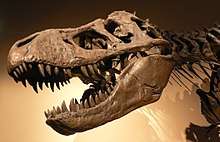Yanliao Biota
The Yanliao Biota is the name given to an assembly of fossils preserved in northeastern China from the Middle Jurassic to Early Cretaceous.[1] It includes fossils from the Tiaojishan Formation, Lanqi Formation, Jiulongshan Formation and Haifanggou Formation. This spans approximately 199 to 146 million years ago.
| Part of a series on |
| Paleontology |
|---|
 |
|
Fossils
|
|
Natural history |
|
Organs and processes
|
|
Evolution
|
|
History of paleontology |
|
Branches of paleontology |
|
Paleontology Portal Category |
Like the Jehol Biota, these deposits are composed of alternating layers of volcanic tuff and sediment, and are considered Lagerstätte. These are some of the best preserved Jurassic fossils in the world, and include many important dinosaur, mammal, salamander, insect and lizard specimens, as well as plants.
History
The first fossils of the Yanliao Biota were found around 1998 near the village of Daohugou in Inner Mongolia. The following year, the first two important specimens were discovered, and published in 2000. Since that time many more have been found from the same area, and in neighbouring provinces.
The Yanliao Biota is made up of fossils from more than one locality, and the geology has been difficult to interpret (see below). It includes what was previously referred to as the Daohugou Biota,[2] and some of it was thought to belong to the Jehol Biota.
Location
The Yanliao Biota comes from outcrops north of the Han Mountains, in the northeast of the People's Republic of China. The most important site is near Daohugou Village in Inner Mongolia, but fossils and outcrops are also found in neighbouring Liaoning Province and Heibei Province.
Geology
The Dauhugou locality lies in the Ningchen Basin in the SE corner of Inner Mongolia. Dauhugou village has fossil-bearing lacustrine (laid down in lakes) strata overlying precambrian basement.
Fossil preservation
The formations that yield the fossils of the Yanliao Biota are known as Lagerstätte, meaning that they have exceptionally good conditions for fossil preservation. The fossils are not only numerous, but also very well preserved. For vertebrates, there are often whole skeletons with soft tissues like skin and fur, colour patterns, and stomach contents. Insects are intact with wings and patterns preserved, and plants have their leaves and flowers still attached. The volcanic ash layers quickly buried the organisms, and created an anoxic environment around them, preventing scavenging and helping preserve them.[1]
Fossils
Dinosaurs
- Anchiornis huxleyi
- Epidendrosaurus ningchengensis
- Epidexipteryx hui
- Pedopenna daohouensis
- Xiaotingia shengi
- Aurornis xui
- Eosinopteryx brevipenna
- Tianyulong confuciusi
Pterosaurs
- Jeholopterus ningchengensis
- Archaeoistiodactylus linglongtaensis (possible Darwinopterus, Martill and Etches, 2012)
- Changchengopterus
- Darwinopterus modularis
- D. linglongtaensis
- D. robustodens
- Jianchangnathus robustus
- Jianchangopterus zhaoianus
- Fenghuangopterus lii
- Kunpengopterus sinensis
- Wukongopterus lii
- Changchengopterus pani
- Dendrorhynchoides mutoudengensis
- Qinglongopterus guoi
- Pterorhynchus wellnhoferi
Mammaliaforms
- Castorocauda lutrasimilis
- Agilodocodon gracilis
- Docofossor brachydactylus
- Microdocodon gracilis
Caudates
- Beiyanerpeton jianpingensis
- Chunerpetron tianyensis
- Jeholotriton paradoxus
- Liaoxitriton daohugouensis
- Pangerpeton sinensis
See also
- Daohugou Biota
References
- Xu, X., Zhou, Z., Sullivan, C. and Wang, Y., 2017. The Yanliao Biota: a trove of exceptionally preserved Middle-Late Jurassic terrestrial life forms. Terrestrial Conservation Lagerstätten. Dunedin Academic Press, London, pp.131-167.
- Sullivan C, Wang Y, Hone DWE, Wang Y, Xu X & Zhang F. 2014. The vertebrates of the Jurassic Daohugou Biota of northeastern China. Journal of Vertebrate Paleontology, 34:2, 243-280, DOI: 10.1080/02724634.2013.787316